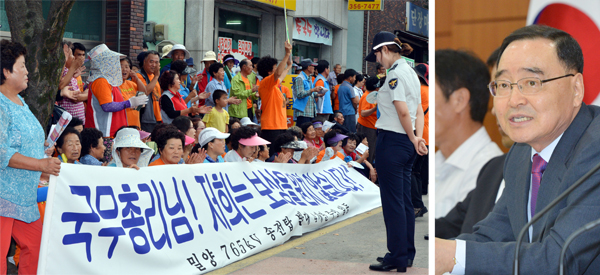Miryang power line deal doesn’t quell all protest

Some Miryang residents, left, rallying Wednesday to protest the construction of a high-voltage transmission line in Miryang, South Gyeongsang, while Prime Minister Chung Hong-won, right, was meeting with representatives of other local people. [NEWSIS]
On Wednesday, Prime Minister Chung Hong-won visited an idled construction site in Miryang, South Gyeongsang, and promised the city compensation measures worth 55.5 billion won ($51 million) in an effort to placate the local residents.
The controversy centers on a government project to erect 161 high-voltage transmission towers along a 90-kilometer (56-mile) route from the Shingori 3 nuclear reactor near Ulsan to an electric power substation in Changnyeong, South Gyeongsang.
The Korea Electric Power Corporation completed the construction of the towers in Ulju and Yangsan, South Gyeongang, in 2011 and 2012. But faced with fierce opposition to the project, the construction of 52 towers in the Miryang area has stopped since May. Residents have rejected the project for fear of potential health risks caused by the power lines.
Under a deal reached by the government, the Korea Electric Power Corporation, the Miryang city government and 10 community residents on Wednesday, the compensation will be supplied by the power corporation.
As part of the support package, Prime Minister Chung signed a memorandum of understanding to set up an 11-megawatt solar energy generator worth 30 billion won in Miryang. The government also agreed to provide 18.5 billion won in direct compensation to residents along the path of the 52 transmission towers.
The compensation plan for Miryang residents was agreed during a time when anxiety over possible power outages has grown. The Shingori 3 reactor is scheduled to begin operating next March, and the government says that transmission line is crucial to get the new reactor’s output to where is needed. Agreement in hand, the government says constructions will resume after the Chuseok holiday.
But that’s not a sure bet. Some residents said they were still not happy with the government support plan. “We do not need compensation,” said Lee Kae-sam, the director of a local residents’ committee opposed to the agreement. “If construction resumes, we will have no choice but to do everything to thwart it.”
About 300 local residents gathered in front of a community center in Miryang’s Danjang neighborhood Wednesday to voice their protests to the prime minister, who paid a call there during his visit. Some protesters have demanded that the voltage of the transmission line be lowered from the planned 765 kilovolts to 345 kilovolts, and others want the lines buried underground, where the earth would sharply reduce radiation from the electrical lines. Seoul has rejected those arguments, noting in particular that burying the lines would cost 2.7 trillion won, five times the cost of the entire aboveground project, and require 12 additional years to build.
BY CHOI JOON-HO, KANG JIN-KYU [jkkang2@joongang.co.kr]










with the Korea JoongAng Daily
To write comments, please log in to one of the accounts.
Standards Board Policy (0/250자)